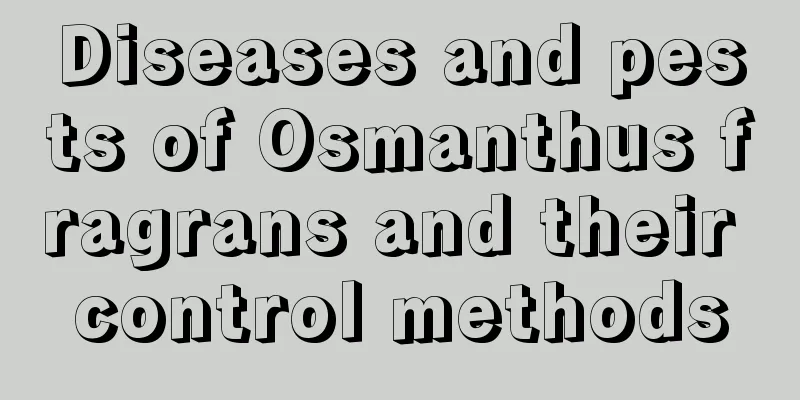Diseases and pests of Osmanthus fragrans and their control methods

Diseases and control methods of Osmanthus fragransBlack spotA disease that is widely distributed throughout the world. When infected, Osmanthus fragrans will have spots on its leaves, about 1 cm in diameter. The leaves will gradually turn yellow and then fall off. Severely damaged Osmanthus fragrans will gradually weaken in growth, bloom late and in small quantities, and is prone to death due to frost damage. Countless spores are formed in the conidiophores and are spread by splashing raindrops, dew, watering, and gardeners working among wet plants. Prevention and treatment methodsWhen planting from the beginning, choose high-quality varieties that are disease-free and resistant. Remove fallen and dead leaves in time after autumn. Pests of Osmanthus fragrans and their control methodsaphidAphids are the fastest reproducing insects, and can reproduce 10 to 30 generations a year. Female aphids can reproduce from birth and do not need males to reproduce. Aphids use their mouth needles with sucking mouths to pierce the epidermis of plants and suck the juice from the tender leaves of the plants, causing the plants to grow slowly. The secretions of aphids also attract ants. Prevention and treatment methodsIf the number is small, kill them manually and spray them with 1500 times diluted 80% DDT emulsion in the initial stage. Red SpiderRed spider mites prefer high temperature and dry environment. Therefore, under hot and dry climatic conditions, they reproduce rapidly and cause serious damage. The insects often gather on the back of leaves and spin silk webs to cause damage. Individual red spider mites are very small, less than one millimeter, so they are not easy to be found. Once they are found causing damage, the damage to the Osmanthus fragrans is often quite serious. Red spider mites attack plants by piercing their mouthparts into the leaves to suck juice, which destroys the chlorophyll and causes the leaves to turn grayish yellow or develop spots. Later, the leaves turn yellow and fall off. In severe cases, the entire plant will lose all its leaves. Prevention and treatment methodsIn the early stage of the disease, diseased leaves should be removed promptly after being discovered. If the plants are severely damaged, they need to be pulled out and burned. When the disease is serious, use 7000 to 9000 times diluted 1.8% avermectin emulsifiable concentrate to spray evenly for prevention and control; or use 2500 to 3000 times diluted 15% cypermethrin emulsifiable concentrate to achieve good prevention and control effects. |
<<: Common diseases of king protea and their prevention and treatment methods
>>: Diseases and prevention methods of Eustoma
Recommend
Why is the ball orchid growing slowly?
The reason why the ball orchid grows slowly One o...
What to do if the leaves of Green Yuanbao turn yellow
Reasons and prevention methods for yellowing leav...
How to save Begonia root rot
1. Increase breathability Reason: Begonia needs g...
Cultivation methods and precautions of Changchun
nutrient Before planting, you should choose soil ...
Peony Pests and Control Methods
Peony pests: scale insects Scale insects are also...
How to care for and water asparagus fern?
Asparagus fern has become a favorite indoor plant...
Do you still use lazy pots to grow flowers? No wonder the flowers can’t survive, they’re all killed by the price increases!
Lazy Basin Let’s take a look at what the lazy pot...
Is Christmas cactus cold-resistant?
1. Is it cold-resistant? It is a tropical plant, ...
How to eat yacon, yacon recipes
1. Cut into pieces and eat raw It is a very sweet...
Cultivation methods and precautions of Wanli Piaoxiang vine
The fragrant vine is easy to grow. Its leaves are...
Can I drink the water soaked with money grass every day?
1. Is it possible? Although money grass has certa...
Cultivation methods and precautions of iris
How to cultivate iris Soil and fertilizer Iris ha...
Are chrysanthemums suitable for deep or shallow pots?
Should chrysanthemums be placed in deep or shallo...
When does canna bloom?
1. Flowering period The flowering period of canna...
Cultivation methods and precautions of oil-spot lily
1. Maintenance methods 1. Soil: The preferred soi...









